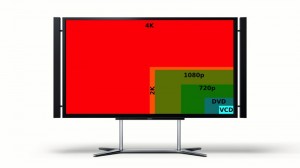Jimmy Fallon’s “Thank You Notes” has got to be one of my favorite segments of the “old” Late Night with Jimmy Fallon. Yes, “Hashtags” is better, but Thank You Notes was the catalyst to the rest of the short segments that have made Jimmy so successful. With Jimmy moving on to The Tonight Show, and Seth Meyers taking over for Late Night, who knows if Thank You Notes will continue, so let’s pay homage to Thank You Notes with a bit of a storage flair.
- Thank you 4K video for realizing the 4 Terabyte drive I just bought will only hold 4 movies.
- Thank you 4K video for getting excited when it says 51% downloaded after watching that annoying download bar for 10 hours.
- Thank you 4K video for having to leave my house to rent a movie…I missed those days.
This week, Panasonic released their new Lumix DMC-GH4. The the “largest-sensored 4K video-capture device yet (for consumers, at least),” according to Wired’s Gadget Lab blog. What does 4K video-capture mean for consumers?
An uncompressed 4k version of the trailer for The Amazing Spiderman takes up a whopping 500GB of hard disk space…At this size, it would be impossible to fit a full-length 4K film onto a terabyte hard disk,” according to the article “How much hard disk space you will need for 4K video files” by Expert Reviews. But, we all know that compression will play into the mix, so for those of you racing out to buy a 4K capable video camera like the Lumix DMC-GH4, no worries, you will not have to buy an enterprise storage system to house all of your movies.
Storage capacity is not the only issue at hand when it comes to higher resolution video. There is the matter of interface speed and the time it takes to transfer from camera to computer. In an article on EECatalog.com, this is made evident. Take for instance Sony’s PS4 which has 4K playback capabilities, but “only two options exist for delivery to the home: downloading from the Internet or renting (from a kiosk). Downloading 4K movies is possible, but downloading a 100GB 4K movie over typical cable modem speeds will require between two and twenty hours per movie.” The article goes on to say that compression will help, but not enough to reduce download times acceptable for consumers. Renting, or downloading 4K movies via a kiosk are more likely, but it is going to take either higher capacity and faster flash storage technology, or faster disk technology interfaces. Current USB 3.0 maybe fast enough for saving a 4K movie to the disk, but not fast enough to stream it to your TV.
 Enter Thunderbolt2 and 10G USB. At 20Gbps and 10Gbps respectively, these standards reduce system latency and enable access speeds to external storage that are comparable to access speeds to internal storage devices. The article predicts that “in the next three years, Thunderbolt 2 will grow in the PC market as a proprietary standard, while both the PC and the consumer world will embrace 10G USB for widespread transport, viewing, capture, and streaming of 4K video in the office and home.”
Enter Thunderbolt2 and 10G USB. At 20Gbps and 10Gbps respectively, these standards reduce system latency and enable access speeds to external storage that are comparable to access speeds to internal storage devices. The article predicts that “in the next three years, Thunderbolt 2 will grow in the PC market as a proprietary standard, while both the PC and the consumer world will embrace 10G USB for widespread transport, viewing, capture, and streaming of 4K video in the office and home.”
So, in the next 3 years, we could be seeing 10 Terabyte hard drives or even SSDs with Thunderbolt2 and/or USB10 interfaces that make enjoying 4K movies a reality whether it’s shot from your Lumix DMC-GH4, or downloaded from a kiosk.
So thank you 4K video for…(you fill in the blank).









Leave A Comment